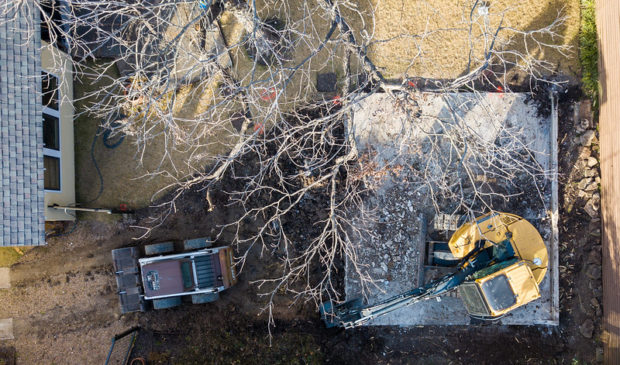Planning Commission links impervious cover to affordable housing
Friday, November 8, 2019 by
Ryan Thornton The Land Development Code draft relies heavily on expanded affordable housing bonus opportunities to reach its nearly 400,000-unit capacity. Altogether, the bonuses would net just under 180,000 units, with about 9,000 of those income-restricted. But site regulations like impervious cover maximums could keep developers from opting into those programs.
The Planning Commission passed two recommendations this week to address that potential defect. One would reduce impervious cover for single units to encourage the development of more units, and another would adjust impervious cover in the Residential 4 house-scale zone so that developers have more space to work with under the bonus options.
The idea, said Commissioner Conor Kenny, is to synchronize impervious cover regulations with the city’s housing goals. Based on his conversations with architects in the community, the 50 percent maximum in Residential 4 zones would make it difficult to get even the base four units and potentially impossible to add any of the additional 1-4 units through the bonus.
Once demand for parking is taken into account, Kenny said, the 50 percent maximum is “essentially writing off affordable units on these sites.” He proposed inserting flexibility in that upper limit that would allow more than 50 percent under the bonus as long as the Watershed Protection Department reviewed the site and identified any necessary water control measures.
Some commissioners wondered aloud what impact that may have on localized flooding in those areas. The code draft is already going to increase allowable cover in many single-family lots from 45 percent to 50 or 60 percent in the transition zones. Commissioner Carmen Llanes-Pulido, the only commissioner to vote against the proposed increase, asked civil engineer Lauren Ross to speak Wednesday about the potential impact of increasing impervious cover even further.
According to Ross, that added impervious cover would likely result in more runoff volume compared to the same site with 45 percent cover today. However, she said, it also depends on where it is located in the watershed and the efficacy of water controls that are added in the process.
On the other hand, Commissioner Greg Anderson noted that the same amount of impervious cover could theoretically house one family or many of them, meaning the impact each resident has on flooding could be lower under the denser development pattern proposed in the transition zones.
Matt Hollon, planning division manager at Watershed Protection, affirmed that higher densities, generally speaking, are a way to reduce the per capita or per unit impacts on localized flooding compared to single-family development and low-density sprawl.
Considering further that single-family lots in Austin are currently allowed 45 percent impervious cover without any water control measures, Kenny said multifamily and “missing middle” residential projects are often required to take precautions that low-density developments have avoided. “The unregulated 45 percent impervious cover is a major problem in this town and there is major flooding because of the single-family development standards.”
To compensate for the added impervious cover in the Residential 4 zone, Kenny proposed reducing by-right impervious cover in all single-unit lots from 45 to 40 percent. Under the amendment, adding an accessory dwelling unit or redeveloping with a duplex would automatically permit 45 percent cover allowance across all zones.
Commissioner James Shieh said the amendment will likely be coming back to consider allowing for a “super site plan light” provision that would allow homeowners to contribute some sort of improvement to their site, such as rainwater harvesting, that would let them attain the 45 percent or higher impervious cover limit.
The amendment as approved would grandfather current homeowners into the new code with their current 45 percent allowance so that they would not be out of compliance.
Hollon said the code draft came very close to Council’s direction not to increase allowable impervious cover in any individual watershed or citywide. Compared to current code, he said, the draft shows a total increase of 0.2 percent, about 350 acres, and that’s under the condition that every site was developed to full potential. Two watersheds, however, showed an increase of over 1 percent.
The draft code’s redevelopment standards should reduce the impact of that minor increase, Hollon said. Today there are roughly 10,000 acres of developed land in the city that lack water and drainage controls. The new code, he said, would require those sites to incorporate those measures as they redevelop, effectively reducing the amount of runoff volume compared to the site today.
The amendment to increase impervious cover under the bonus in the Residential 4 zone passed 11-1 with Llanes-Pulido opposed. The amendment to reduce single-unit impervious cover to 40 percent passed 12-0.
The Planning Commission will take up its code amendments again Monday before making its recommendation to Council on Tuesday, Nov. 12.
Photo by Lars Plougmann made available through a Creative Commons license.
The Austin Monitor’s work is made possible by donations from the community. Though our reporting covers donors from time to time, we are careful to keep business and editorial efforts separate while maintaining transparency. A complete list of donors is available here, and our code of ethics is explained here.
You're a community leader
And we’re honored you look to us for serious, in-depth news. You know a strong community needs local and dedicated watchdog reporting. We’re here for you and that won’t change. Now will you take the powerful next step and support our nonprofit news organization?




